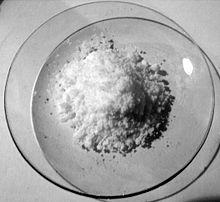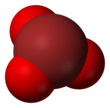 | |||
| | |||
| Names | |||
|---|---|---|---|
| IUPAC name Sodium bromate | |||
| Other names Sodium bromate(V) Bromic acid, sodium salt | |||
| Identifiers | |||
3D model (JSmol) | |||
| ChEBI | |||
| ChemSpider | |||
| ECHA InfoCard | 100.029.237 | ||
| EC Number |
| ||
PubChem CID | |||
| RTECS number |
| ||
| UNII | |||
| UN number | 1494 | ||
CompTox Dashboard (EPA) | |||
InChI
| |||
SMILES
| |||
| Properties | |||
Chemical formula | NaBrO3 | ||
| Molar mass | 150.89g/mol | ||
| Appearance | colorless or white solid | ||
| Odor | odorless | ||
| Density | 3.339 g/cm3 | ||
| Melting point | 381 °C (718 °F; 654 K) | ||
| Boiling point | 1,390 °C (2,530 °F; 1,660 K) | ||
| 27.5 g/100 mL (0 °C) 36.4 g/100 mL (20 °C) 48.8 g/100 mL (40 °C) 90.8 g/100 mL (100 °C) | |||
| Solubility | soluble in ammonia insoluble in ethanol | ||
| −44.2·10−6 cm3/mol | |||
Refractive index (nD) | 1.594 | ||
| Structure | |||
Crystal structure | cubic | ||
| Thermochemistry | |||
Std molar entropy (S | 130.5 J/mol K | ||
Std enthalpy of formation (ΔfH⦵298) | -342.5 kJ/mol | ||
Gibbs free energy (ΔfG˚) | -252.6 kJ/mol | ||
| Hazards | |||
| Main hazards | Oxidizing agent | ||
| Safety data sheet | ICSC 0196 | ||
| R-phrases (outdated) | R8, R36, R37, R38 | ||
| S-phrases (outdated) | S26, S27, S36, S37, S39 | ||
| NFPA 704 (fire diamond) | |||
| Flash point | 381 °C (718 °F; 654 K) | ||
| Related compounds | |||
Other anions | Sodium chlorate Sodium iodate | ||
Other cations | Potassium bromate Calcium bromate | ||
Related compounds | Sodium bromide Sodium hypobromite Sodium bromite | ||
Except where otherwise noted, data are given for materials in their standard state (at 25 °C [77 °F], 100 kPa). | |||
Sodium bromate, the inorganic compound with the chemical formula of NaBrO3, is the sodium salt of bromic acid. It is a strong oxidant.
Uses
Sodium bromate is mainly used in continuous or batch dyeing processes involving sulfur or vat dyes and as a hair-permagent, chemical agent, or gold solvent in gold mines when used with sodium bromide.
Production
Sodium bromate is produced by passing bromine into a solution of sodium carbonate.[1] It may also be produced by the electrolytic oxidation of sodium bromide. Alternatively, it can also be created by the oxidation of bromine with chlorine to sodium hydroxide at 80 °C.
3 Br2+3 NaCO3=5 NaBr+NaBrO3+3 CO2
Human health issues
Bromate in drinking water is undesirable because it is a suspected human carcinogen.[2][3] Its presence in Coca-Cola's Dasani bottled water forced a recall of that product in the UK.[4]
References
- ^ https://chemiday.com/en/reaction/3-1-0-1145
- ^ "Potassium Bromate (Group 2B)". International Agency for Research on Cancer: Summaries and Evaluations. Canadian Centre for Occupational Health and Safety. Retrieved 2008-03-09.
- ^ Kurokawa, Yuji; Maekawa, A; Takahashi, M; Hayashi, Y (July 1990). "Toxicity and carcinogenicity of potassium bromate—a new renal carcinogen". Environmental Health Perspectives. 87: 309–35. doi:10.1289/EHP.9087309. JSTOR 3431039. PMC 1567851. PMID 2269236.
- ^ "Coke recalls controversial water". BBC News. 2004-03-19. Retrieved 2008-03-09.
External links


